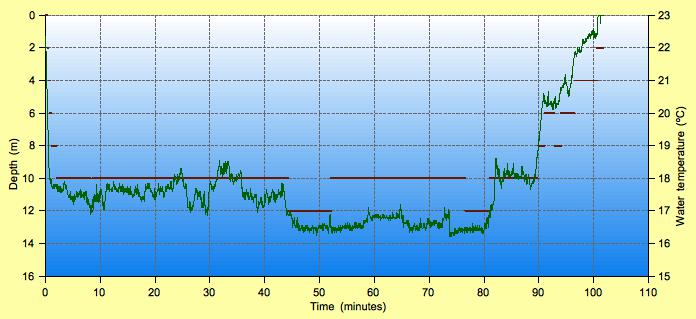Dive Details
Location
Date
Saturday 15 December 2018
Time
12:34pm - 2:15pm
Buddy
Malcolm Nobbs
Seas
Some surge and current
Visibility
3 to 8 metres
Duration
100 minutes
Surface interval
Maximum depth
13.6 m
Average depth
10.6 m
Water temperature
17°C
Dive Profile from Garmin Descent Mk1

Tides at Botany Bay AEDT
Note that tides at dive site may vary from above location.
High
2:49am
1.23m
Low
8:18am
0.76m
High
2:34pm
1.43m
Low
9:28pm
0.53m
Details
For the second dive of the second day, Malcolm and I dived The Monument again. I was keen to look for more pygmy pipehorses and Malcolm was happy with pygmy pipehorses and the red-fingered anglerfishes.
We again got in from the protected area a third of the way to The Steps. The tide was a little higher than the first dive so the entry was a little easier. We descended and swam towards the sand line. The visibility was down a little from the first dive but was still 5 to 8 metres. There was a bit of surge and some current. The water temperature was around 17°C.
I swam straight to the small orange red-fingered anglerfish. I took a few photographs and then let Malcolm have a go. I cruised on ahead.
We swam past Block Rock and the next sponge covered rock and then on to Pygmy Hollow. I spotted the male pygmy pipehorse in the gap but could not find any others on the adjacent rock. While Malcolm was photographing the pygmy I looked around the adjacent rocks.
We headed over to Honey's Rock and the orange red-fingered anglerfish on the shoreward side of the rock. As I was taking photographs of the anglerfish I got the impression that my right strobe wasn't firing but I couldn't be sure.
We swam along the Deep Wall and I looked for the seahorses as I always do. I also kept an eye out on the sand for weedy seadragons.
We headed up over the wall and I had a quick look for pygmy pipehorses on the rock near the top of the wall. I then went over to the sponge garden to look for seahorses.
We checked out the slope below Seahorse Rock for "Nia", the brown White's seahorse but I still couldn't find her. It has been a few weeks now since I last saw her.
We continued along the reef past Split Rock and on to the rock where the grey red-fingered anglerfish had been for weeks. The orange red-fingered anglerfish I'd spotted on the first dive was still there.
We swam down to the Valley of the Pygmies. I found the male at the south-eastern end of the Valley first. While I was taking its photograph I realised that my right strobe was definitely not firing. It looks like the tube has gone as all the other functions work fine. I then found the partner of that male up and a bit to the left from him. After taking photographs I pointed them both out to Malcolm and moved on.
I looked for the female on the slope that was closest to the Carijoa covered rock. She was where I saw her on the first dive. I then found her partner. I next found the tiny juvenile. Then the pink female that is probably the partner of the reliable male. Finally, I saw the reliable male.
I headed to the Carijoa and sponge covered rock and spotted both the pink female and the red and white male pygmy pipehorses. I also saw the grey female and pink male I'd found on the first dive. I pointed all 4 pygmies out to Malcolm and then went back to the slope.
On the slope I found another juvenile pygmy pipehorse. This one was pink and larger than the other juvenile. That made 2 pairs on the rock, 3 pairs on the slope and 2 juveniles; 12 pygmy pipehorses in total at the Valley of the Pygmies.
We headed along the NW-SE Wall and up to the top and then cut across to the corner. We headed to the large Carijoa rock at the end of the East-West Wall and to the small orange red-fingered anglerfish there. We took some photographs before moving on.
We went a short distance west along the East-West Wall before ascending the wall to 5 metres and swimming along the top of it. We then cut in and headed south over the kelp. We continued south and I found a sea hare on the sand. We stayed underwater until it was too shallow and then waded out through the channel in front of the flagpoles.